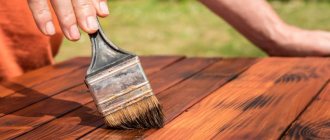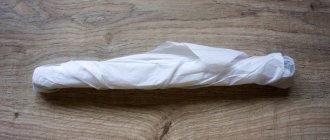Etching, wood tinting: getting the desired color
Etching and tinting of wood allows you to achieve a deep, uniform shade and emphasize the living texture of the wood. The RMNT website will tell you what dyes and stains need to be used to achieve a particular shade of wood. All recipes are old, time-tested.
There are two options for deep wood tinting:
- Hand dyeing with a plain cloth swab that will not leave fibers on the surface. The swab is moistened with mordant, the dye is applied to the wood;
- Soaking in mordant. According to experts, this is a more reliable way to get a color that will not be afraid of water and light. The wood is soaked in an enamel vessel of the required size; the wait will vary depending on the type of wood and the concentration of the solution. Then the wood is washed and dried slowly without access to natural light.
Wood is colored due to the fact that mordants react with tannins. The best types of wood to paint are oak, beech and chestnut - they have a lot of tannin. Birch and linden are slightly less susceptible to etching, and coniferous wood is the worst.
The process itself, as we see, is not too complicated. The main thing is to choose the right dye to get the desired shade. Let's list the old recipes:
- Black. In order for your piece of wood to become jet black or dark gray after pickling, you need to use iron, or rather, iron filings and acetic acid. By the way, the same color is given to wood by firing using the Japanese Shou-Sugi-Ban technology, to which the portal Rmnt.ru devoted a separate article;
- Orange, golden. This tone can be achieved by soaking ordinary poplar branches in water. Five to six days in such a solution in a bright room and the tree will have a noble golden color;
- Silver. All you need is rainwater and iron filings;
- Grey. You can get wood of this shade by soaking it together with willow bark;
- Wenge is a valuable tree. But ordinary potassium permanganate will help you achieve a similar shade. And at first glance, for example, beech will be indistinguishable from exotic wenge;
- Brown. Regular onion peels will help you get all shades of brown. With its help you can get a reddish tint. In addition, to dye wood brown, you can use walnut shells, coffee decoction with soda and apple tree bark;
- The blue color comes from oak sawdust and iron filings. To obtain a blue color, wood is soaked together with copper shavings;
- An interesting effect can be obtained using a natural dye such as wolfberry. With its help, adding other pigments, you can get blue, red, black, and brown shades;
- The yellow-green color will help to obtain an infusion of rhubarb root; hemp leaves will color the tree in a dark green hue.
As you can see, all the ingredients we have listed are natural, except for potassium permanganate and metal shavings. Experts in the field of wood etching often mix such natural mordants with chemical ingredients: copper, iron, zinc sulfate, 2% Epsom salt (magnesium sulfate heptahydrate), potassium chromium.
It is important to remember that the result of etching will depend on the type of wood! So, under the influence of Epsom salt, oak will turn brown, and birch will turn purple.
Imitation walnut wood. How to paint wood "walnut".
To give a wooden surface the color of walnut wood, you can use the following technology: Mix 50 grams of potassium permanganate in 1 liter of warm boiled water and then immediately treat the surface of the wood with the resulting solution. If the shade of the product being processed is not dark enough, the treatment can be repeated several times until the proper result is achieved. If, on the contrary, you need to lighten an overly dark tone of the product, then the surface of the wood can be treated with a brush or swab with a 2% solution of hydrochloric acid. After treatment, the wood should be rinsed with clean water or thoroughly wiped with a damp sponge.
The very chemical effect of the stain solution is the formation of a dark precipitate of manganese dioxide as a result of the reaction of potassium permanganate with the cellulose of solid wood. Hydrochloric acid converts this manganese dioxide into colorless manganese chloride (chemical formula - MnCl2).
Brighter and brighter: tinting wood yourself
Antique wooden furniture always serves as interior decoration. But what if you want to update your decor a little? And I seem to be completely bored with the natural color of wood... Solid wood furniture tinting – a great way out! Doing tinting yourself is not that difficult. The main thing is to select the necessary materials and be extremely careful in the process.
Uniform tinting of pine: 4 steps for a perfect result
In retail outlets, there are often many other related species in stacks of finished pine boards, but sellers do not make much distinction between them, calling everything “pine.” Such species are very close in botanical classification, but still, they are not quite pine and they have slightly different properties. That is, they will absorb stain differently. However, this is also observed in pure pine: even the same board can have a different resin content and different absorbency in different areas. What can we say if the boards chosen are from different trees.
Unpredictability is something to consider when starting to use stain for this breed. To determine its level and boundaries, test samples are used. This is the most reliable method to check the quality and parameters of the material.
Selecting materials
Several types of coating are suitable for tinting wood yourself. Their choice depends on what result you want to achieve in the end. Here are the most common coloring compositions:
- Acrylic paint . You can buy it not only in construction stores. It saturates the surface well, but there is a significant drawback - when wood strongly absorbs the tinting composition, the fibers of its structure rise strongly. Therefore, it is better to mix acrylic with other substances for decoration. For example, with molding or glazing.
- Mordant . This is a dry pigment that is diluted with water before application. The big plus is that this dye does not saturate the surface, but simply clogs small particles of wood. Tinting with this composition will help to avoid unevenness and roughness of the structure. The mordant does not just color, it penetrates deep and acts chemically. This means that the brightness of the resulting colors is guaranteed! But after tinting the wood using this method, the array must be varnished. Otherwise, if moisture gets in, stains may remain on the furniture.
- Wood stain . The best option for tinting wood yourself. It does not lift fibers and does not require the application of an additional layer of varnish. You can also purchase patination - this is almost the same as stain, but its shades can be adjusted.
What does water-based varnish consist of?
Water-based varnish ingredients: water + binder + additives.
The varnish can be one-component , containing polyurethane or acrylic as a binder. There is two-component varnish in which both binders or some others are present.
water-based acrylic varnish It is not very durable; high humidity is contraindicated for it. Therefore, this varnish is used to coat products that are not subject to heavy loads. In any case, it’s definitely not worth covering the floors with it.
Polyurethane water-based varnish is reliable - it is used where significant loads are possible on the coating, it is not “eaten” by spilled alcohol or even stronger chemicals.
Water-based polyurethane varnish is highly durable
Two-component water-based varnishes are good because they show the positive aspects of all their ingredients, which complement each other.
Let's start tinting
There are several ways to tint. Paint by hand, spray or dip. The most common method that can be successfully used at home is painting with a brush. So, the old wooden bedside table is ready for its color transformation. And this is what she has to do:
- Cleaning and sanding . Before painting, it is important to level the surface and make the wood structure as smooth as possible. An ordinary sandpaper will help with this.
- Applying stain . Using a roller or brush, spread the paint evenly over the wood along the grain. And to remove excess, simply rub the stain with a dry cloth or swab.
- Paint drying . This stage is extremely important. It is better to be patient and wait until the layer dries thoroughly. Only in this case can you evaluate the final result of the work and the resulting shade. If it is not saturated enough, you can apply the stain again.
- Varnish coating . This completion of tinting prolongs the wear resistance of the colored wood product.
Do-it-yourself wood tinting is a rather labor-intensive process. However, if you love creativity and are not afraid to try new things, then this type of work will certainly bring maximum pleasure. And bright wooden interior items will delight you every day!
Still have questions?
Call or
How to coat a surface with tinted water-based varnish
Stirring the tinted product must be especially thorough, since the pigment particles may be distributed unevenly throughout the volume. When adding water to such a varnish or mixing several cans, it is better to prepare a mixture for the entire surface at once. If you paint by diluting and mixing the varnish in parts, you can get areas of different shades.
Test tinted varnish on selected areas
You can tint water-based varnish yourself. To do this, pour into it a little (5-8% of the volume) tinting impregnation, which also has a water base.
Care in applying varnish with tone is required. If the layer in some area is thicker, the coating in this place will be darker. To avoid this, it is advisable to use a spray gun or a foam swab to apply tinted varnish.
2-3 layers of thin layers of tinted varnish are better than one thick one - with several layers the color of the coating is more uniform.
To obtain a beautiful, visually deep layer of varnish, a darker varnish is first applied to the wood, and the upper layers are made colorless or lighter.
Two-component varnish coating withstands heavy loads
Never apply varnish to an old coating that has worn off in places on the surface - in these places the finish will look lighter. In this case, the old coating will have to be cleaned off. Although there is another option - use a varnish darker than the old one.
Keep in mind that if the old varnish has worn down to the ground in some area, the exposed wood will absorb the new varnish more actively than the rest of the surface. It is not necessary to remove all the old coating - just coat it twice with primer, and the absorbency will be evened out. You can do it differently: instead of impregnating, cover the surface with a colorless varnish, and after it dries - with a tinted one.
Source: www.domstoy.ru
Interior Design Blog
What is wood tinting oil?
The positive properties of wood are enormous: high strength, environmental friendliness, ideal heat-saving properties, natural decorativeness. But when exposed to natural conditions, wooden objects and construction wood used for external and internal work become deformed and rot. In addition, it is susceptible to mold, mildew, and damage by insects. However, all these negative nuances can be easily eliminated if you use oil tinting on wood. To protect wood (wood products) from getting wet, and to protect against negative influences such as rotting, mold, and fungus, impregnation is used - a special tinting oil for wood. Tinting oil is deeply absorbed, filling pores and fibers, strengthening the structure of the wood, which becomes moisture resistant and gains increased strength.
Using wet paper
This is also one of the methods of multi-layer painting.
I apply thinly diluted ocher as the first layer and dry it with a hairdryer. Next, I take a sheet of paper and tear it into pieces of different shapes and sizes. Try to have complex shapes and not just straight stripes. I wet the paper with water and place the pieces on my piece of wood. The next color is applied with a palette knife. I chose warm gray. You need to apply it so that pieces of paper do not move off during the process. You can safely leave a slight sloppiness in the application, uneven thickness of strokes. While the paint is still fresh, I carefully lift the paper with a palette knife and remove them. And I leave it to dry.
Then I tear up the next batch of pieces of paper, moisten them and place them on the board. I try to ensure that there are different areas under the paper - both gray and ocher. I apply the next color - dark ocher, and remove the paper without waiting for it to dry. Drying the paint. Then all stages are repeated as many times as you want to add colors to your work.
I apply red ocher, and the very last layer is burnt umber. This method differs from others in that each layer has its own small thickness, and it seems as if entire layers of paint were actually falling off the board after numerous stains.
Operating principle of the oil
The principle of operation of tinting oil is impregnation of wood, deep absorption, filling all pores, in order to exclude access of insects, dust, moisture and dirt to the fibers, imparting strength, resistance to negative external influences and biological aging. Tinting oil applied to the surface of wood emphasizes the natural beauty wood and preserves its natural texture, creates a feeling of warm and natural wood, allows you to give the wood an original appearance and unexpected shades.
Proper grinding
A step-by-step proven method on how to properly sand a pine board:
- to begin with, you can take coarse-grained discs for a grinder and, changing them in descending order, finish the procedure with disc No. 180;
- then, additionally sand it manually using a block with sandpaper No. 180. It is necessary to move along the fibers: this will remove marks from the sander;
- The final stage is sanding the ends with sandpaper with grit No. 220. This will prevent them from excessively absorbing the stain.
What types of wood oils are there?
In modern domestic and foreign chemical industries, thanks to amazing developments, there is a wide range of types of wood oils, including: for interior use, for exterior use, for different types of wood, universal, with and without beeswax, for fire protection with the addition of special material. Made from natural resins and oils. Among the main and frequently used natural oils are sunflower, linseed, soybean, olive, jojoba, and pine tree resin. The palette of tinting oils for wood is varied and large, and therefore the oil not only completely protects the wood and extends its service life, but also gives it bright multi-colored shades to suit every taste, giving the product sophistication and beauty.
Technology of imitation mahogany at home.
To paint a wooden surface with imitation mahogany, you need to boil 5 grams of carminic acid in 100 ml of water for 3 hours and then cool the resulting chemical solution. Then the thoroughly polished surface of ordinary wood is brushed several times with this solution, and the already dried surface is treated with a solution containing 6 grams of tin chloride (SnCl2) and 3 grams of tartaric acid in 100 ml of water.
As a stain, you can use any solution of cherry-red dye (for example, for fabric), and use it to achieve the desired shade by applying the solution to the surface of the wood in several stages.
Properties and characteristics of tinting oil for wood
All tinting oils have very important properties when interacting with wood. Oiled wood:
- becomes less susceptible to wear, contamination, chipping, cracks and scratches;
- does not fade in the sun;
- does not respond to changes in temperature and air humidity;
- ideal for porous wood, since, penetrating deep into the pores of the wood, it does not clog them, while the wood “breathes”;
- non-toxic, harmless for impregnation in children's rooms;
- does not require pre-treatment of wood with soil;
- does not require constant dilution and stirring while working with it;
- does not have an unpleasant or pungent odor.
Oils for wood tinting are characterized by the fact that, regardless of their composition and area of application, they resist the formation of bacteria, are absorbed well and quickly, and increase the service life of treated products. And not only. There are special oils for wood, which are typical for wooden household items, various wooden and plywood shelves that interact with food. It is very important to buy a wood tint and treat high humidity areas on kitchen furniture, as it can prevent bacteria from molding on the wood.
Pine primer
Experience in processing pine wood shows that applying stain to its clean surface leads to uneven tone and staining.
The carpenters conducted an experiment with test samples to determine which primer composition would provide better color uniformity. The surface was treated with shellac for furniture, a factory primer-conditioner for wood with uneven absorption and a polyurethane composition. The latter showed the best result.
After applying and drying the composition, the surface is lightly sanded in the direction of the fibers with a sponge with abrasive No. 320 and a liquid stain is applied.
How do tinted oils differ from each other?
Tinting oils differ from each other in composition, technology of application and purpose (for external or internal work), but they all serve mainly to protect wood from the destructive influence of the external environment and aggressive influences of various types.
Flaxseed oil is in particular demand among consumers, after tinting the surfaces acquire a beautiful silky, matte shine or a clear, natural shade of colored linseed oil, according to the color palette. Other characteristic features of linseed oil are better absorption than other oils and resistance to the development of bacteria. Linseed oil can be used as an independent decorative coating for both interior and exterior use. Impregnating wood with linseed oil improves the appearance of wood, increases the service life of products, and can be tinted perfectly to match any shade. Treated products are resistant to cracks, fading, and drying out.
Lakra
Tinted lakra varnish is produced in various modifications and is used as a decorative and protective finish for wood materials located indoors. A tinted lakra varnish is produced, which has antiseptic properties and can be used to coat baseboards, ceiling and wall panels, doors, and other products.
This varnish mixture decorates and makes wooden surfaces more attractive, emphasizes and highlights the natural texture and pattern of wood, and allows you to tint products to match any type of wood. Lakra varnish is made from environmentally friendly and safe substances for humans. The composition can be applied using various methods - spray gun, brush or roller.
Advantages of oils over other compounds
Wood has never gone out of fashion; it is rightfully considered the most popular material in construction, as the noble shades of valuable wood fill it with luxury and wealth. If previously wood was popular only due to the lack of other materials for construction, now we try to buy wooden materials for the main reason - environmental safety and durability. What should I use for processing (tinting) wooden structures, pieces of furniture, various products in the house, in the country, in the apartment, in the bathhouse, on the balcony, in the garage? With all the variety of materials for wood processing, in order to ensure a long and effective service life, it is worth choosing and buying the material that, according to its technical characteristics, is suitable for use for specific purposes. When choosing a material, you must consider:
- type of wood;
- operating conditions (humidity, air or room temperature);
- history of previous coatings, if any.
Stain, varnish, and oil are mainly used for tinting wood.
Liquid impregnation for wood, called stain, based on its production can be water, alcohol and oil. It is produced in the form of a ready-to-use solution and in powder form, allowing you to paint basically in the shades of any wood from the lightest to the darkest. Water-based stain has a significant drawback - it lifts the wood fibers, which makes the wood susceptible to moisture. Therefore, before applying stain, you need to wet the wood, let it sit for a while, and then saturate it with stain.
Alcohol-based stain dries very quickly - this is the main drawback, as a result of which stains form on the treated surface. Uniform coloring is obtained if the stain is applied from a spray gun.
Oil stain gives wood any color that can be obtained by mixing oil-soluble dyes, diluted with White Spirit solvent, dries quickly, does not lift fibers and is applied evenly. To achieve the desired color of wood, it must be coated in at least two layers, and each of these layers must be completely dry.
How to apply water-based varnish
Apply a water-based primer to the surface you are going to paint. After priming, the wood does not absorb the varnish as actively, and its consumption will be less. In addition, the varnished surface will be smoother and more even.
If the surface has slight unevenness, it is better to use a matte varnish, since a glossy coating reveals defects more strongly, while a matte coating muffles them and masks them to some extent.
Water-based varnish can be applied to old varnish. Just before you re-varnish the surface, test it on a small area to check the compatibility of the coatings. If the result is positive, which happens in most cases, sand the old layer and rinse with water (first with soap, then with clean water). Varnish – after complete drying.
A roller and spray gun are the best tools for applying varnish. A brush can cover small surfaces.
It is convenient to apply varnish to the surface using a spray bottle.
Brush and roller for varnishing
If the room is too hot and dry, postpone work. In this case, the moisture from the varnish will evaporate too quickly, and this always leads to coating defects.
Methods of applying oils
Treating wood with oil begins with preparing the surface.
- do not wipe the surface with a damp cloth (wood moisture content should not exceed 15%);
- Clean the wood from dirt and plaque and dry thoroughly.
- if work is carried out outdoors, then the weather should be sunny, and if indoors, then it should be dry.
Next, you can proceed in the two most commonly used ways: rubbing and soaking.
Rubbing consists of rubbing the wood 3-4 times along the grain with a cotton rag or any other lint-free cloth soaked in oil. You can also use a brush or applicator for rubbing, but in this case the oil consumption will be much higher.
When applying, constantly remove excess oil with a clean cloth.
We always make sure to maintain the consumption indicated by the manufacturer on the can.
After the 1st layer has dried, if necessary, cover the 2nd layer to obtain a darker color.
The second method, soaking, is used to treat small objects: crafts, knife handles and other objects. In this case, the product is completely immersed in oil for a certain time, then wiped and dried. The disadvantage of this method is the high consumption compared to the rubbing method.
What to consider when applying water-based varnish
- Water-based varnish should not be diluted with solvents. You can add water, but not more than 10-15%.
- Stirring the varnish before applying to the surface is mandatory.
- Varnishing, as well as drying of the coating, should take place with doors and windows closed to prevent drafts.
- Avoid direct sunlight on the fresh coating.
- To avoid sagging or bubbles, before applying the last, finishing layer of varnish, you need to go over the varnished surface with sandpaper.
- At first, it is better not to walk on already dried varnish in shoes with hard soles, but to place pieces of fabric or cardboard under the furniture - the water-based varnish gradually gains hardness and resistance to damage.
Advantages of ZAR tinting oil over other oils
ZAR oil products are in great demand among customers. The presented product has no analogues in the world. Always available for sale, used mainly for interior woodwork. When applying oil to horizontal surfaces, it is recommended to cover the top with ZAR polyurethane varnish, regardless of the base, or with tung oil. When using it outside, it is necessary to coat it with varnish for exterior use (ZAR Ultra Exterior).
The formula of linseed and tung oil allows them to be applied to vertical and horizontal surfaces.
The uniqueness of ZAR tinting oil for wood is that the consumption of this oil reaches up to 70 sq.m. per 1 quart (0.946 L) oil. Compared to oils from other manufacturers, this consumption is at least 2 times less.
The advantage of these oils is that they are oils that dry out quickly compared to other oils, such as soybean, hemp, and sunflower. A product coated with ZAR tinting oil, compared to other oils, does not fade over time during use and is not toxic. The UV filter in the formula of these oils prevents the wood from fading when exposed to sunlight.
The surface treated with ZAR tinting oil has a very high level of water resistance and durability. Another advantage of using ZAR oils is that it gives the wood a noble matte shade.
Choosing the “right” boards
Pine has significant knotiness, but in our case this is part of its attractiveness and uniqueness. Regular, non-rotten, hard knots, which are an integral part of the structure of the board, are not a hindrance, but “dead” such elements of wood should be avoided. That is, the rotten ones, those that stagger, fall out. Also, boards with accumulations of these formations near the core or with knots around which the wood grain lines sharply change direction should be rejected.
But even boards with these disadvantages are quite suitable for use. The problem can be solved in a simple way: by securing the falling knots with epoxy glue. Do not be afraid that over time its adhesive properties will weaken and the board element will fly out or crumble. This glue is based on epoxy resin, which is extremely durable after drying.
: Making tea
Basic kit. The materials needed for this process are simple and cheap, but the bark powder must be ordered by mail.
Making a tea from the bark powder to saturate the wood significantly increased the tannic acid content. By first using bark tea and then adding a solution of vinegar and iron, I finally began to get closer to the effect I was looking for. It was a little pale though, and not the intensity I wanted. So I applied another layer of bark tea and it made all the difference. The tea completely eliminated the pale tint and the wood became a deep jet black color.
The process of blackening in this way is quite simple. Saturate the wooden surface with the bark infusion, wait until the surface moisture is absorbed into the wood, then add the iron solution. Then apply another layer until you achieve the desired result.
Brushed firing and metallic patina (dry brush)
I have another board with firing and brushing. By combining firing, brushing and dry brushing, you can achieve different visual effects, lightening the texture of the wood or, conversely, darkening it. And I want to show the metallic patina in this example. I paint the board deep black, using velvet black from the Acrylic De Luxe line.
Metallic paints look best and shimmer on dark surfaces. Next, I take Decolor metallic paints and work using the dry brush technique: I put paint on a brush (it is better to use flat, coarse bristles), wipe off the excess on a napkin and begin painting in the direction of the wood grain.
It is important not to overdo it and stop in time. The result is an elegant metallized coating that emphasizes the wood grain.
: Making an iron solution
I wipe a walnut blank with an iron solution.
Before using a vinegar and iron solution, I always test it with an oak or cherry stick dipped in the solution. It should become quite dark after a few minutes. If not, you can just wait another day or make another batch. I haven't found a solution to this specific error. I may not always be thorough in removing oil from steel wool. I highly recommend preparing this iron solution at least a week or more before you actually need to paint the project. You'll want to get a feel for the entire process before you apply it to an actual piece of furniture.
The iron solution is stored in a jug for months. As the steel wool dissolves, gas is released. If the container is sealed, it may burst. Just because the iron has dissolved so much that it is not visible does not mean that the reaction has stopped. Therefore, make sure that there is a 1mm escape hole in the cover.
The bark tea can be prepared just before applying to the item. I simply add a heaping tablespoon of bark powder to half a liter of hot tap water and stir well.
Brushing without firing + washing technique
Of course, you can brush wood without firing it, which is exactly what I did before I bought the burner.
This can be done with special drill attachments and hard metal brushes. Or brush by hand, which is what I do. This, of course, is a great way to keep warm when there is no heating) You definitely need to sand the board after brushing so as not to get splinters.
Next I start painting. I apply purple and immediately wash off the unabsorbed paint with a wet rag. I introduce an additional color in some places - ultramarine - and do the same with it.
This technique allows you to delicately highlight the texture of the board. Next, I take green Chameleon paint, apply it to the entire surface, and also wash away the residue, allowing it to remain only in the depths of the pores. After drying, a delicate pearlescent effect is obtained.











